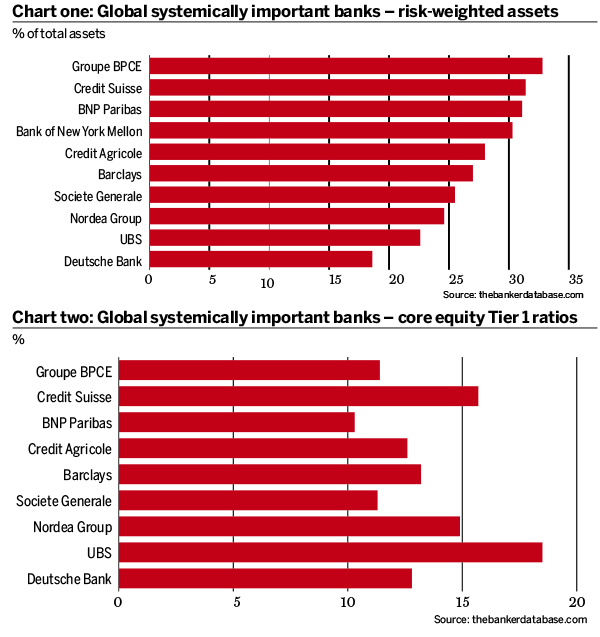The Basel Committee is consulting on whether to put a floor under banks’ use of internal models to calculate capital ratios.
In December 2014, the Basel Committee on Banking Supervision (BCBS) began consulting on a potentially far-reaching change to its system of regulating bank capital. The key Basel ratio is calculated by comparing capital against the bank’s risk-weighted assets, so a lower-risk asset should attract a lower capital charge. Depending on their level of sophistication, banks can choose (with approval from their supervisor) whether to measure these risk-weighted assets (RWAs) using their own internal models, or using standardised formulae set by the BCBS.
Since the financial crisis, however, there have been growing concerns about banks using internal models too aggressively to lower their overall capital requirement. Aggregated data, which is available for 21 of the 30 banks designated global systemically important banks (G-SIBs) by the Financial Stability Board, shows that risk-weighted assets have fallen from 72% of total, unweighted assets in 1994 to just 42.5% of unweighted assets a decade later.
In response, the BCBS has now proposed using the standardised methods for calculating RWAs as a floor for internal models. Crucially, the calibration of such a floor will be left to the end of the whole review process, so banks cannot yet calculate the precise impact of the reform. Nonetheless, it is possible to build a picture of those banks that might be most affected. Banks that currently have the lowest ratio of RWAs to gross total assets are the ones whose internal models are most likely to hit the floor that the BCBS plans to create.
An examination of the 30 G-SIBs quickly shows that the 10 most affected are all in Europe, with the exception of Bank of New York Mellon. Given BNY Mellon’s substantial focus on asset management and securities services (loans to retail and corporate clients accounted for less than 3.3% of total assets in 2013), many of its assets will be low-risk bonds.
The European institutions have much broader business models, either as universal or predominantly investment banks. Consequently, the scope for RWA floors to affect their capital ratios is greater. In terms of countries, all four of France’s largest banks fall into the top 10 on this measure, as do the two large Swiss investment and private banks.
Of course, the other side of the equation is how much capital banks already hold. Even if they are forced to nudge the value of RWAs higher, this will not have such a profound effect if the denominator – their capital – is already strong. We have used core equity Tier 1 (CET1), the strictest definition that will be used in the Basel III rules that come into full force in 2019. (This number is not available for BNY Mellon).
In this regard, the so-called 'Swiss finish' of very high capital requirements imposed by their national regulators means Credit Suisse and UBS stand out well above other banks on this list. Nordic-based Nordea also performs well, and it should not be forgotten that this data is for end-2013. Since then, Deutsche Bank has raised a further €8bn in new capital, partly to improve its performance in the European Central Bank’s stress test that was completed in October 2014. Again, on the measure of CET1 ratios, France’s largest banks do not fair especially well.
By contrast, US banks appear to fare well in this ranking. The ratio of RWAs to total assets for the six largest US G-SIBs range from 46.8% for Morgan Stanley to 74.8% for Wells Fargo – the best performing G-SIB by this measure. However, this is partly due to the use of US Generally Agreed Accounting Principles (GAAP). Unlike European accounting rules, GAAP allows banks to net derivative positions, reducing the apparent size of total assets for US banks. Consequently, US banks may not be as unaffected by RWA floors as they appear to be at first glance.



